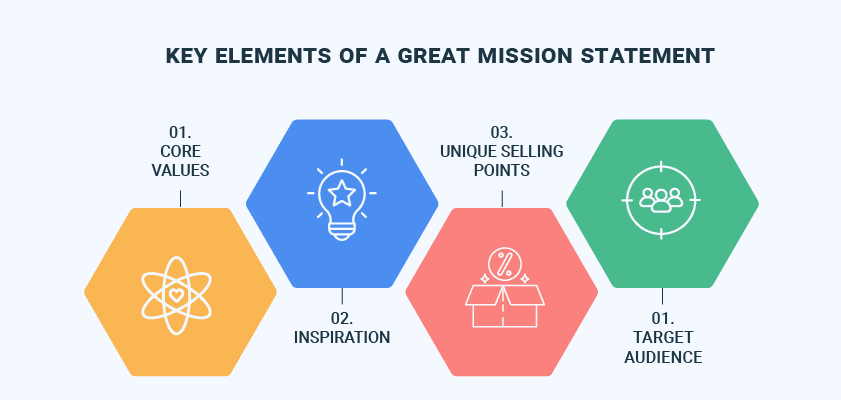Every business is as unique as its audience. Each one strives to put its best foot forward, especially when it comes to customers.
While there are countless marketing strategies—social media, content, email—all of the above marketing materials are linked to the business’s common purpose.
This is where a mission statement comes in. A business plan mission statement displays the purpose and values of a business, giving a clear message to customers about what your business is about.
But writing a mission statement that’s catchy and concise is a task. So, in this article, let’s see how to write a mission statement and why you need it.
What is a mission statement?
A mission statement is a short actionable statement that specifies your company’s core purpose, principles, and goals. It states the value your company creates for your customers, employees, stakeholders, and owners.
In short, it’s a snippet representing why your business exists and what it does.
People often use mission and vision statements interchangeably, but they are different. Let’s see how.
Mission statement vs. vision statement
Your mission statement focuses on what you do and how you do it. It details the organization’s current purpose, core values, and primary objectives. This provides a framework for the organization’s day-to-day operations.
In contrast, a vision statement describes where you aim to reach in the future. It outlines the long-term goals and the desired future position of the company. A clear vision statement inspires and motivates stakeholders by offering a clear and compelling future direction.
Now that we’ve clarified the difference between a mission statement and a vision statement, let’s dive into why the mission statement is so important.
Why is a mission statement important?
Mission statements are necessary for any business. They not only guide internal operations but also communicate the company’s purpose to external people.
Here are some of the reasons why you need to have a great mission statement in a business plan:
Gives clear direction
A mission statement outlines the company’s purpose. Thus, it acts as a guiding star for decision-making and strategic planning, ensuring that all actions align with the company’s core values and primary goals.
Inspires and motivates employees
A well-crafted mission statement can inspire and motivate employees by providing them with direction. It also helps them understand how their roles will contribute to the company’s goals, especially the larger ones, encouraging unity among them.
Engages customers
A concise mission statement communicates the business’s values and company’s goals to customers, helping to build trust and loyalty. It tells customers what the organization stands for and why they should choose its products or services over competitors.
Supports marketing efforts
A mission statement can enhance branding and marketing efforts by clearly conveying the business’s identity and purpose. It helps create a strong, recognizable brand that resonates with customers, investors, and other audiences, boosting the business’s market position.
Now that you know the importance of the mission statement, let’s dive deep into learning how to write one.
How to write a mission statement for your business plan?
A company’s mission statement is barely three sentences long. But, ironically, its simplicity makes it so tricky to write.
Here are the following steps that make it easy for you to write a mission statement:
Step 1: Ask the right questions
Before you begin the mission statement writing process, understand your business in its entirety. Articulating the answers to the following questions can be helpful:
- In what industry are you working?
- Who’s your target audience?
- What are your offerings?
- What are your unique selling propositions (USPs)?
- What customer problems do you solve through your offerings?
- What’s the value you deliver through your product or services?
- What’s your brand personality?
- What are your competitive advantages?

Want to Generate a Mission Statement for Your Business?
Craft a strong and purposeful mission statement in minutes with our easy-to-use Free AI Mission Statement Generator.
Step 2: Organize the answers
After answering all the above questions, organize them into the following categories:
The value you add to your customers
List down how you make your customers’ lives better. It can be through your products, the methods you use to deliver them, or through non-profit work and community service.
For instance, if you own a green tea brand, you add value to your customers by providing healthy beverages. Additionally, if you support recycling, you provide a sense of ethical consumerism.
The value you add to your employees
Here, write down how you create value for your employees.
These could be the:
- Employee retention strategies you employ
- Benefits and perks you offer
- Work culture in your company
- Training programs you offer
The value you add to your owners
Here’s the thing: Not many mission statements talk about the owners and stakeholders.
However, it can be beneficial to state how your business adds value to them. Why? Doing so can be a subtle indication to prospective investors that they might want to be associated with your company.
For example, “Our mission is to deliver exceptional value to our customers while ensuring significant returns and growth opportunities for our owners and stakeholders.”
The impact you want to create
Here, state the mission you want to achieve in the long run through your offerings. State the impact you aim to create via value addition for your target audience, employees, owners, and stakeholders.
Remember the green tea brand example? The goal of such a company could be to promote a healthy lifestyle and advocate for sustainability.
Step 3: Draft, edit, and review
Once you have organized all the answers, start creating drafts of your mission statement. Don’t make it a lengthy essay; remember, a good mission statement is supposed to be short and simple. Below are the components you need to incorporate in your mission statement.
Key elements of a great mission statement

- Core values: Mention how you create and deliver value to your customers, employees, investors, and society at large.
- Inspiration: Define the motive for people to follow you. Why do they want to buy from you, work with you, or invest in you?
- USP: Highlight the unique aspects that make the organization distinct and valuable.
- Target audience: Identify the primary stakeholders or target audience the organization serves. This could include customers, employees, shareholders, or the community.
Without a mission statement, you may get to the top of the ladder and then realize it was leaning against the wrong building. – Dave Ramsey
Step 4: Update when needed
It’s necessary to keep updating your mission statement to align with your company’s current situation.
As your business grows and evolves, so do your company’s goals, target audience, and guiding principles. Therefore, regularly revisiting and revising your mission statement ensures that it reflects the current company’s vision and direction.
A strong and concise statement can keep your investors hooked and inspire your team. Don’t just write buzzwords. A mission statement should be accurate, ambitious, ethical, and achievable.
Make it a practice to review your mission statement frequently—at least once a year or whenever significant changes occur in your business. This proactive approach helps maintain alignment between your mission and your company’s path forward.
Mission statement examples of popular brands
A well-written mission statement tells everything about your company. Here are some examples of well-crafted mission statements by famous companies:
1. Starbucks
To inspire and nurture the human spirit – one person, one cup, and one neighborhood at a time.
In the first part of the statement, Starbucks describes the work culture it promotes and the customer service delivered. The second part points to its mission of growing and expanding.
2. L’Oréal
To provide the best in cosmetics innovation to women and men around the world with respect for their diversity.
L’Oréal’s mission statement is simple and direct focusing on two aspects.
One: Provide the best products.
Two: Promote inclusivity by creating products for a diverse population.
3. Apple
To bring the best personal computing products and support to students, educators, designers, scientists, engineers, businesspersons, and consumers in over 140 countries around the world.
Apple’s mission statement doesn’t have much wordplay and clearly conveys the point. It emphasizes three key aspects: its products, its audience, and its scope of business.
4. Amazon
To be Earth’s most customer-centric company, where customers can find and discover anything they might want to buy online.
Amazon aims to satisfy customers the most by providing a vast selection of products and making shopping easy. This is exactly reflected in the company’s mission statement.
5. Microsoft
To empower every person and every organization on the planet to achieve more.
Microsoft’s mission statement is simple yet powerful. It concentrates on empowering individuals and organizations by providing them with the technology to reach their full potential.
6. Nike
To bring inspiration and innovation to every athlete in the world. If you have a body, you are an athlete.
Nike’s mission statement focuses on inspiring all levels of athletes and the inclusivity of everyone as an athlete. Besides that, they also emphasis innovation in sportswear.
7. Tesla
To accelerate the world’s transition to sustainable energy.
This statement is about forward-thinking. It’s all about speeding up the use of sustainable energy solutions.
8. Disney
To entertain, inform, and inspire people around the globe through the power of unparalleled storytelling, reflecting the iconic brands, creative minds, and innovative technologies that make ours the world’s premier entertainment company.
Disney’s mission statement emphasizes its commitment to creating magical experiences for audiences worldwide. Through their iconic brands, creative talents, and innovative technologies, Disney aims to delight and inspire people of all ages, shaping the entertainment world.
9. Google
To organize the world’s information and make it universally accessible and useful.
Google’s mission statement is loud and clear. It emphasizes organizing all the information available globally and making it accessible to everyone.
10. Meta
To give people the power to build community and bring the world closer together.
Meta’s mission statement is empowering and inclusive. It emphasizes providing people with the tools to build communities and fostering connections to bring the world closer together.
Conclusion
In summary, a mission statement is the essence of a business in under 30-40 words. It shows what your business is all about and why it matters.
However, creating a mission statement along with a solid business plan is necessary yet challenging. Consider using software like Upmetrics to ease your journey of business planning and financial forecasting.
Upmetrics guides you step-by-step, helping you create a clear and effective mission statement with a business plan that sets you up for success.
Start crafting yours today with Upmetrics and see where it takes you!

